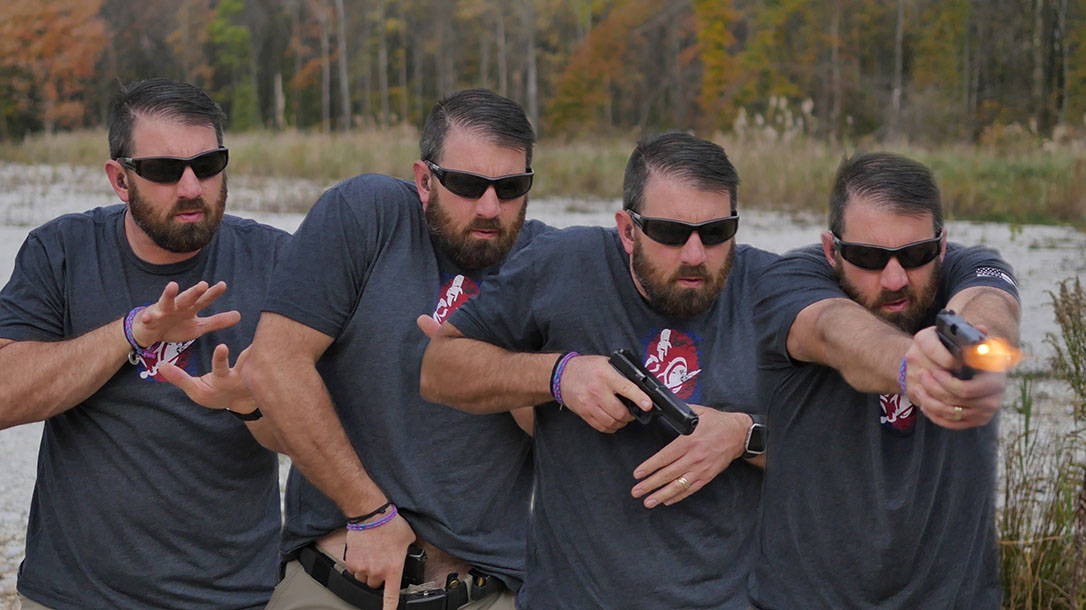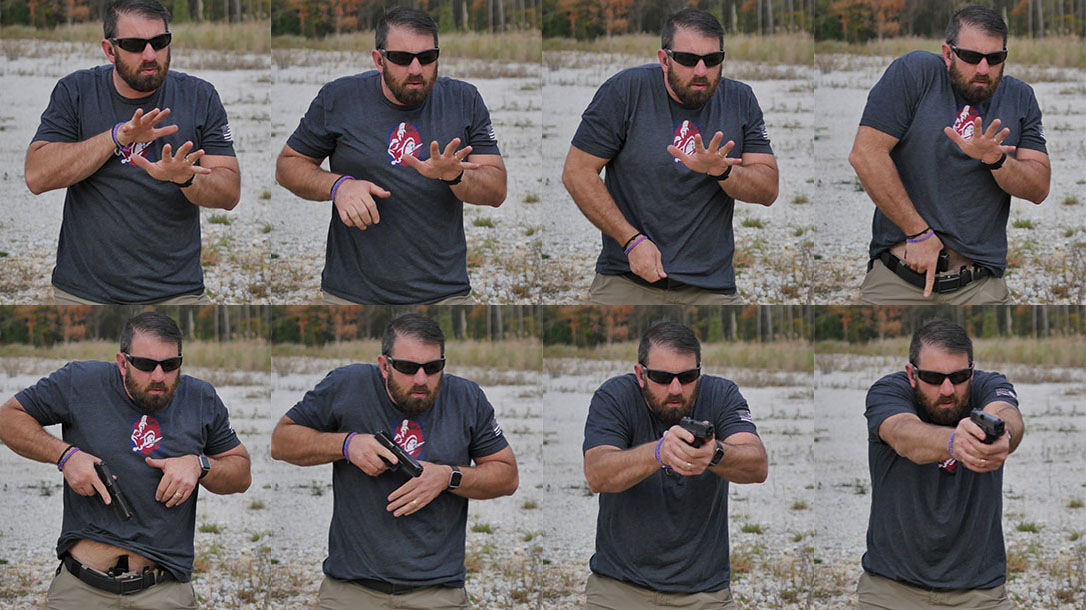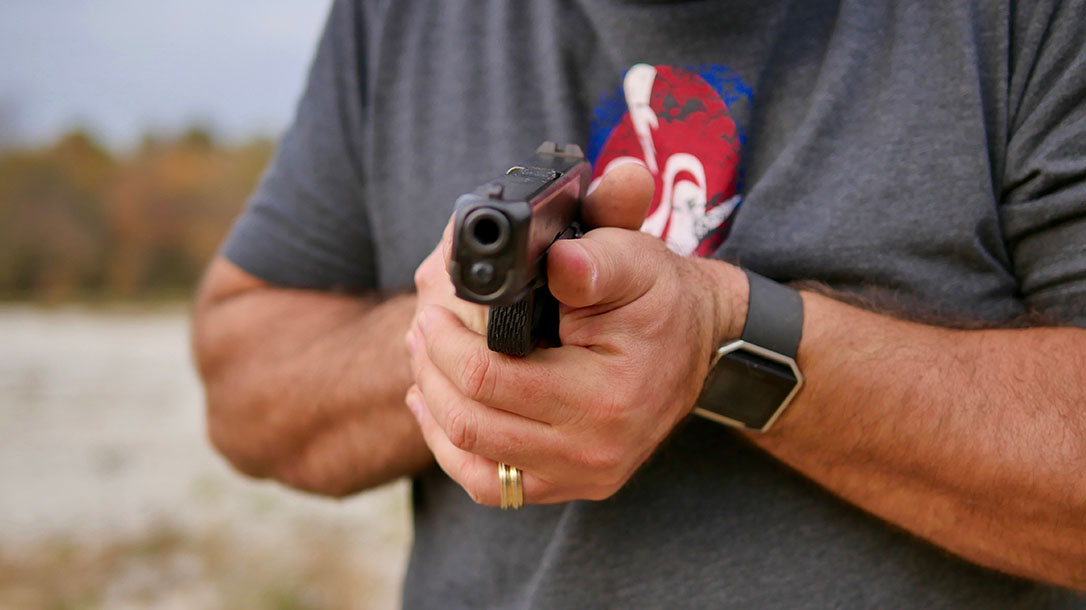When it comes to winning a violent encounter, getting the first hits can significantly increase your chances of prevailing. The sooner you force your attacker to begin protecting himself, the faster you shift their focus away from the attack. Just as important is the idea that, as a violent encounter progresses, it tends to become more dynamic and more difficult to turn the tide.
Responding to a violent situation with speed has value. Incorporate the following tips into your defensive handgun practice to make progress toward the physical skills you need to get first hits fast.
Advertisement — Continue Reading Below
1. Get A Grip
One of the best ways to ensure fast first hits with your handgun is to maximize your grip. A solid grip helps to position your hand for a consistent presentation to your threat. Set your hand up for a smooth trigger press and manage recoil for faster follow-up shots.
So, you need to establish and habituate a grip that works well for you. Your hand and how it interfaces with your handgun are unique. You need to determine the one- and two-handed grips that work the best for you. Qualified professional instruction can help you make grip adjustments that aid in precision and recoil management while maximizing speed. Then your dedicated practice will burn that grip into your neural pathways. Every time you shoot or even just handle your handgun is an opportunity to habituate your one- and two-handed grips.
Once you find and habituate your best grip, you must learn to achieve as much of that grip as possible while the gun is still in the holster. Your carry position and holster can be strong determining factors in how much of a grasp you get on the gun in the holster. The better the holster design, the better grip you can get on the gun while it is still in it. You’ll be better served by establishing your full grip in the holster instead of shifting the grip after you draw.
Advertisement — Continue Reading Below
Make sure that you can get your pinky, ring finger and middle finger between the grip of the handgun and the belt. Your holster may be designed or set up in a way that makes it difficult to fit the ring finger between the belt and the gun, but this will force you to shift your grip as the gun comes out of the holster.
It’s also important to practice drawing from concealment. Establishing your grip on the gun is usually the longest part of the drawstroke in dynamic violent situations. If you carry concealed, this adds another layer to the already complex problem. Take the time to train and practice accessing your gun from your typical cover garment. It is tempting to head to the range with a fishing vest for practice. However, if you conceal under an untucked, closed-front shirt, you are making a mistake.
2. Practice Efficiency
An efficient presentation from the holster is a critical component in getting the first hits in a defensive scenario. Your drawstroke needs to be simple and practical. An efficient drawstroke should provide you with the ability to get the gun from the holster and oriented towards the threat with speed. A defensive drawstroke should also provide opportunities to put rounds on the threat from a retention position so that you can deal with threats in physical contact as well as at greater defensive distances.
Advertisement — Continue Reading Below
When practicing your drawstroke, work to minimize excess movement. Economy of motion is one of the keys to speed, so place an emphasis on economical movement. Once the muzzle of your gun is oriented toward the target, drive the gun in a straight line toward the threat. Not only will this be the shortest distance, but you will also have the ability to fire with effect on your threat at any time, and your will reach full extension with your pistol’s sights steady on the threat.
Once you are comfortable with your presentation from the holster, it needs to be practiced consistently. Quality repetitions will help to automate your presentation from the holster. With that, you don’t need to invest thought energy into making it happen. Developing speed is less about doing something fast and more about doing it the right way again and again. If you want to be fast, be consistently correct in your practice and the speed will come.
3. Shoot With Precision
Although shooting fast is, in general, a different skillset than shooting precise shots, there is some overlap. As with practicing your drawstroke, pressing the trigger correctly is much more important for learning a fast, precise trigger press than pressing the trigger quickly. Learn how to press the trigger well and the speed will come with the practice.
Advertisement — Continue Reading Below
Obviously, one great way to get feedback on your trigger press is to shoot at very small targets. Even a minor flinch or jerk can cause a miss. With practice, you will develop very refined aiming skills and a smooth trigger press to complement them.
Your standard target is full of options for extreme precision. Instead of the main target area, select logos or letters in the words on the target. You can also take things a step further. Instead of aiming at a letter or number, aim at a part of the letter or number. For example, try to put the shot through the hole in the center of the numeral 6.
Shooting with extreme precision can be a great exercise in pushing your limits and helping you to develop realistic confidence in how much sight and trigger control refinement you can accomplish. Knowing your limits of skill is the first step in understanding what you can do. It serves as a prerequisite of knowing how fast you can do it. Taking some time to shoot with extreme levels of precision helps to both develop skill and develop an understanding of what your skill is. Both come in handy when you need to get hits in first.
Advertisement — Continue Reading Below
4. Throttle Back
Getting the first hits when you’re defending yourself from a lethal threat seems like it is all about speed. At times, however, the key to being fast can be to slow down.
Imagine you are driving an Indy car into a tight turn. I don’t know much about driving a racecar. However, I do know that if you take the turn too fast, you are going to lose control of the car and end up off the course. In racing, you need to match the speed of the car to the maneuvers that you need to navigate through. In defensive shooting, you need to match your speed to the demand for precision that the shot places on you. The smaller or more distant the target, the more likely you will need to slow down to improve your sight alignment or refine your trigger press. The closer or larger the target is, the less control you need to exercise over the gun and the more speed you can apply to making the shot.
Advertisement — Continue Reading Below
Invest training and practice time in this concept by randomizing your need for speed and your need for precision. Vary your distance from the target or provide yourself with multiple target sizes so that you are forced to determine how much control the shot requires and how much speed you can use while making the shot. Having a training partner can help to randomize your practice. But you can also simply flip a coin or roll a die to tell you what to shoot. You can also use the countdown timer on your phone while you or your target are moving to tell you when to shoot.
Make sure you only slow down what you need to slow down. Shooters commonly slow down the wrong actions. You see, the only area where you may need to slow down and/or refine your control over the gun is in the final fractions of a second before the shot breaks. The rest of the motions required to get the gun on target can be at full speed. Grasping the gun, drawing from the holster and driving the gun onto the threat can all be flat-out. As the gun begins to reach full extension, simply downshift and allow the gun settle smoothly into and parallel with your line of sight, bring your attention to the sights to align and place the sights, then smoothly press the trigger to the rear.
First Hits: Accuracy Is Final
Making one shot that hits what needs to be hit is a vastly superior technique than sending a large number of rounds at your threat hoping that you will get the hit you need. As the old saying goes, you can’t miss fast enough.
Advertisement — Continue Reading Below
Getting first hits fast requires a combination of physical skills and tactics. Taking the time to develop your physical skills on the range is a critical part of your self-defense plan. In addition, knowing that you can get fast first hits when you need to most can provide an important confidence boost and shift in mindset that can reduce the likelihood that you will ever need hits on your threat in the first place.
Investing effort in getting a solid grip on your defensive handgun, developing efficiency in your drawstroke, shooting with extreme precision and knowing when to put the brakes on are all important physical skills that you should develop to help ensure you are able to get fast first hits.

























